In Silico Identification of Novel Derivatives of Rifampicin Targeting Ribonuclease VapC2 of M. tuberculosis H37Rv: Rifampicin Derivatives Target VapC2 of Mtb H37Rv
Abstract
1. Introduction
2. Results and Discussion
2.1. Ribonuclease VapC2 Protein
2.2. Ligand Growing Experiment
2.3. ADME Properties
2.4. Prediction of Antimicrobial Activity of RIF Derivatives Using QSAR Modeling
2.5. Molecular Docking
2.6. Protein–Ligand Intermolecular Interaction Analysis
2.7. Molecular Dynamics Analysis
2.8. Chemical Synthesis of Potentially Identified Newly Designed RIF Derivative
3. Materials and Methods
3.1. Protein Retrieval
3.2. Prediction of the Binding Site
3.3. Ligand Selection
3.4. Derivative Designing
3.5. In Silico Prediction of Drug Likeness, Bioavailability and Toxicity
3.6. Quantitative Structure–Activity Relationship (QSAR) Analysis
3.7. Molecular Docking
3.8. Molecular Dynamics Simulation
3.9. Chemical Synthesis of RIF Derivatives
4. Conclusions
Supplementary Materials
Author Contributions
Funding
Institutional Review Board Statement
Informed Consent Statement
Data Availability Statement
Acknowledgments
Conflicts of Interest
Sample Availability
References
- World Health Organization. Rapid Communication: Key Changes to the Treatment of Drug-Resistant Tuberculosis; WHO: Geneva, Switzerland, 2022. [Google Scholar]
- World Health Organization. Global Tuberculosis Report. 2021. Available online: https://www.who.int/publications/i/item/9789240037021 (accessed on 26 April 2021).
- Johnson, A.; Johnson, T.; Khan, A. Thermostats in Molecular Dynamics Simulations. UMass 2012, 1, 29. [Google Scholar]
- Johnson, M.M.; Odell, J.A. Nontuberculous mycobacterial pulmonary infections. J. Thorac. Dis. 2014, 6, 210. [Google Scholar] [PubMed]
- Ramage, H.R.; Connolly, L.E.; Cox, J.S. Comprehensive Functional Analysis of Mycobacterium tuberculosis Toxin-Antitoxin Systems: Implications for Pathogenesis, Stress Responses, and Evolution. PLoS Genet. 2009, 5, e1000767. [Google Scholar] [CrossRef] [PubMed]
- Arcus, V.L.; Rainey, P.B.; Turner, S.J. The PIN-domain toxin-antitoxin array in mycobacteria. Trends Microbiol. 2005, 13, 360–365. [Google Scholar] [CrossRef] [PubMed]
- Becq, J.; Gutierrez, M.C.; Rosas-Magallanes, V.; Rauzier, J.; Gicquel, B.; Neyrolles, O.; Deschavanne, P. Contribution of Horizontally Acquired Genomic Islands to the Evolution of the Tubercle Bacilli. Mol. Biol. Evol. 2007, 24, 1861–1871. [Google Scholar] [CrossRef] [PubMed]
- Sassetti, C.M.; Boyd, D.H.; Rubin, E.J. Genes required for mycobacterial growth defined by high density mutagenesis. Mol. Microbiol. 2003, 48, 77–84. [Google Scholar] [CrossRef]
- Maurya, S.; Alhazmi, A.; Vidyarthi, A.S.; Jain, A.; Singh, V.; Khan, F.; Haque, S.; Mishra, B.N. In-silico study reveals potential antitubercular drug targets unique to Mycobacterium tuberculosis H37Rv. Minerva Biotechnol. Biomol. Res. 2022, 34, 71–79. [Google Scholar] [CrossRef]
- Cheeseright, T.; Mackey, M.; Rose, S.; Vinter, A. Molecular Field Extrema as Descriptors of Biological Activity: Definition and Validation. J. Chem. Inf. Model. 2006, 46, 665–676. [Google Scholar] [CrossRef]
- Tian, W.; Chen, C.; Lei, X.; Zhao, J.; Liang, J. CASTp 3.0: Computed atlas of surface topography of proteins. Nucleic Acids Res. 2018, 46, W363–W367. [Google Scholar] [CrossRef]
- Spark, Version 10.5.6. Cresset: Litlington, Cambridgeshire, UK. 2020. Available online: http://www.cressetgroup.com/spark/ (accessed on 18 March 2019).
- Daina, A.; Michielin, O.; Zoete, V. SwissADME: A free web tool to evaluate pharmacokinetics, drug-likeness and medicinal chemistry friendliness of small molecules. Sci. Rep. 2017, 7, 42717. [Google Scholar] [CrossRef]
- Potts, R.O.; Guy, R.H. Predicting skin permeability. Pharm. Res. 1992, 95, 663–669. [Google Scholar] [CrossRef]
- Lipinski, C.A. Drug-like properties and the causes of poor solubility and poor permeability. J. Pharmacol. Toxicol. Methods 2000, 44, 235–249. [Google Scholar] [CrossRef] [PubMed]
- Lipinski, C.A.; Lombardo, F.; Dominy, B.W.; Feeney, P.J. Experimental and computational approaches to estimate solubility and permeability in drug discovery and development settings. Adv. Drug Deliv. Rev. 2001, 46, 3–26. [Google Scholar] [CrossRef]
- Ghose, A.K.; Viswanadhan, V.N.; Wendoloski, J.J. A Knowledge-Based Approach in Designing Combinatorial or Medicinal Chemistry Libraries for Drug Discovery. 1. A Qualitative and Quantitative Characterization of Known Drug Databases. J. Comb. Chem. 1999, 1, 55–68. [Google Scholar] [CrossRef] [PubMed]
- Veber, D.F.; Johnson, S.R.; Cheng, H.-Y.; Smith, B.R.; Ward, K.W.; Kopple, K.D. Molecular Properties That Influence the Oral Bioavailability of Drug Candidates. J. Med. Chem. 2002, 45, 2615–2623. [Google Scholar] [CrossRef] [PubMed]
- Egan, W.J.; Merz, K.M.; Baldwin, J.J. Prediction of Drug Absorption Using Multivariate Statistics. J. Med. Chem. 2000, 43, 3867–3877. [Google Scholar] [CrossRef]
- Muegge, I.; Heald, S.L.; Brittelli, D. Simple Selection Criteria for Drug-like Chemical Matter. J. Med. Chem. 2001, 44, 1841–1846. [Google Scholar] [CrossRef]
- Yang, H.; Lou, C.; Sun, L.; Li, J.; Cai, Y.; Wang, Z.; Li, W.; Liu, G.; Tang, Y. admetSAR 2.0: Web-service for prediction and optimization of chemical ADMET properties. Bioinformatics 2019, 35, 1067–1069. [Google Scholar] [CrossRef]
- Cheng, F.; Li, W.; Zhou, Y.; Shen, J.; Wu, Z.; Liu, G.; Lee, P.W.; Tang, Y. admetSAR: A Comprehensive Source and Free Tool for Assessment of Chemical ADMET Properties. J. Chem. Inf. Model. 2012, 52, 3099–3105. [Google Scholar] [CrossRef]
- Khan, F.F.; Alam, S. QSAR and docking studies on xanthone derivatives for anticancer activity targeting DNA topoisomerase IIα. Drug Des. Dev. Ther. 2014, 8, 183–195. [Google Scholar] [CrossRef]
- Trott, O.; Olson, A.J. AutoDock Vina: Improving the speed and accuracy of docking with a new scoring function, efficient optimization, and multithreading. J. Comput. Chem. 2010, 31, 455–461. [Google Scholar] [CrossRef] [PubMed]
- Huey, R.; Morris, G.M.; Forli, S. Using AutoDock 4 and AutoDock vina with AutoDockTools: A Tutorial; The Scripps Research Institute Molecular Graphics Laboratory: La Jolla, CA, USA, 2012; p. 92037. [Google Scholar]
- Rani, N.; Hazra, S.; Singh, A.; Surolia, A. Functional annotation of putative fadE9 of Mycobacterium tuberculosis as isobutyryl-CoA dehydrogenase involved in valine catabolism. Int. J. Biol. Macromol. 2019, 122, 45–57. [Google Scholar] [CrossRef] [PubMed]
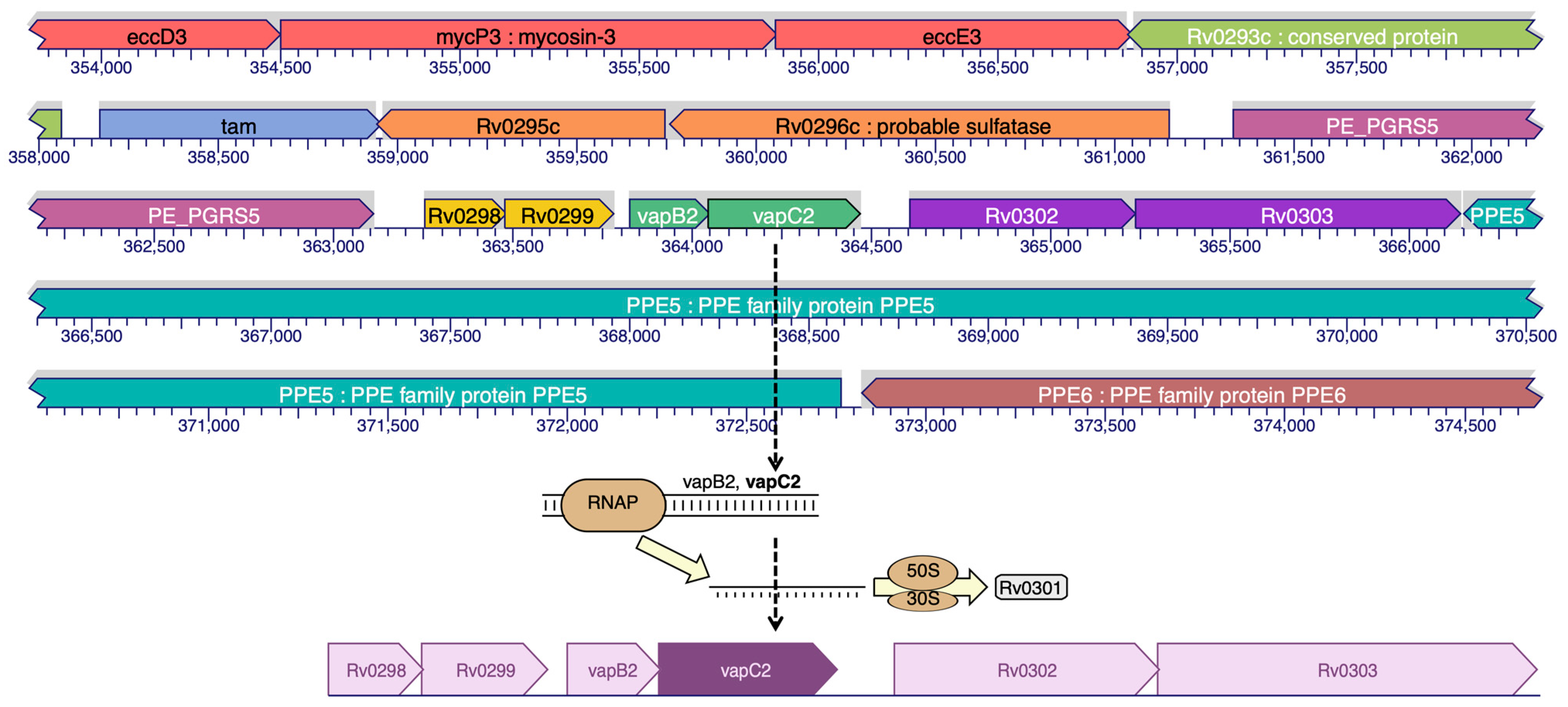
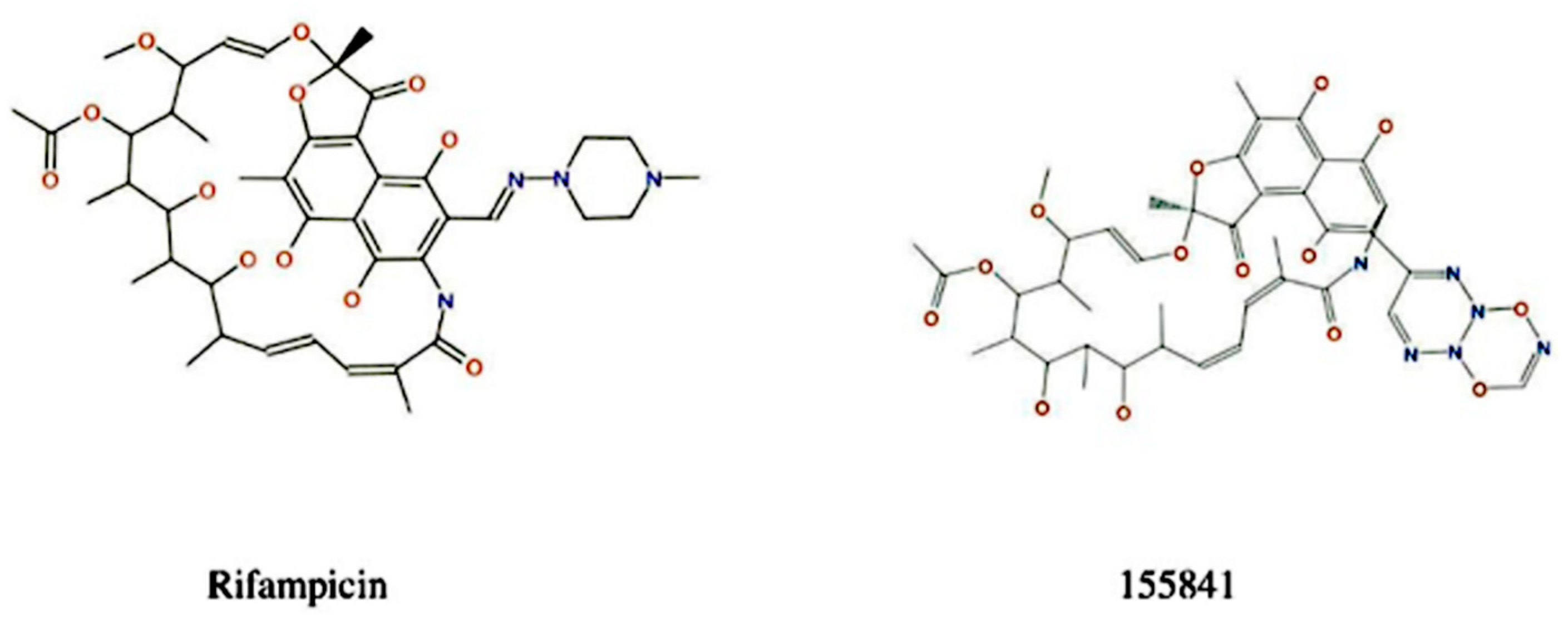
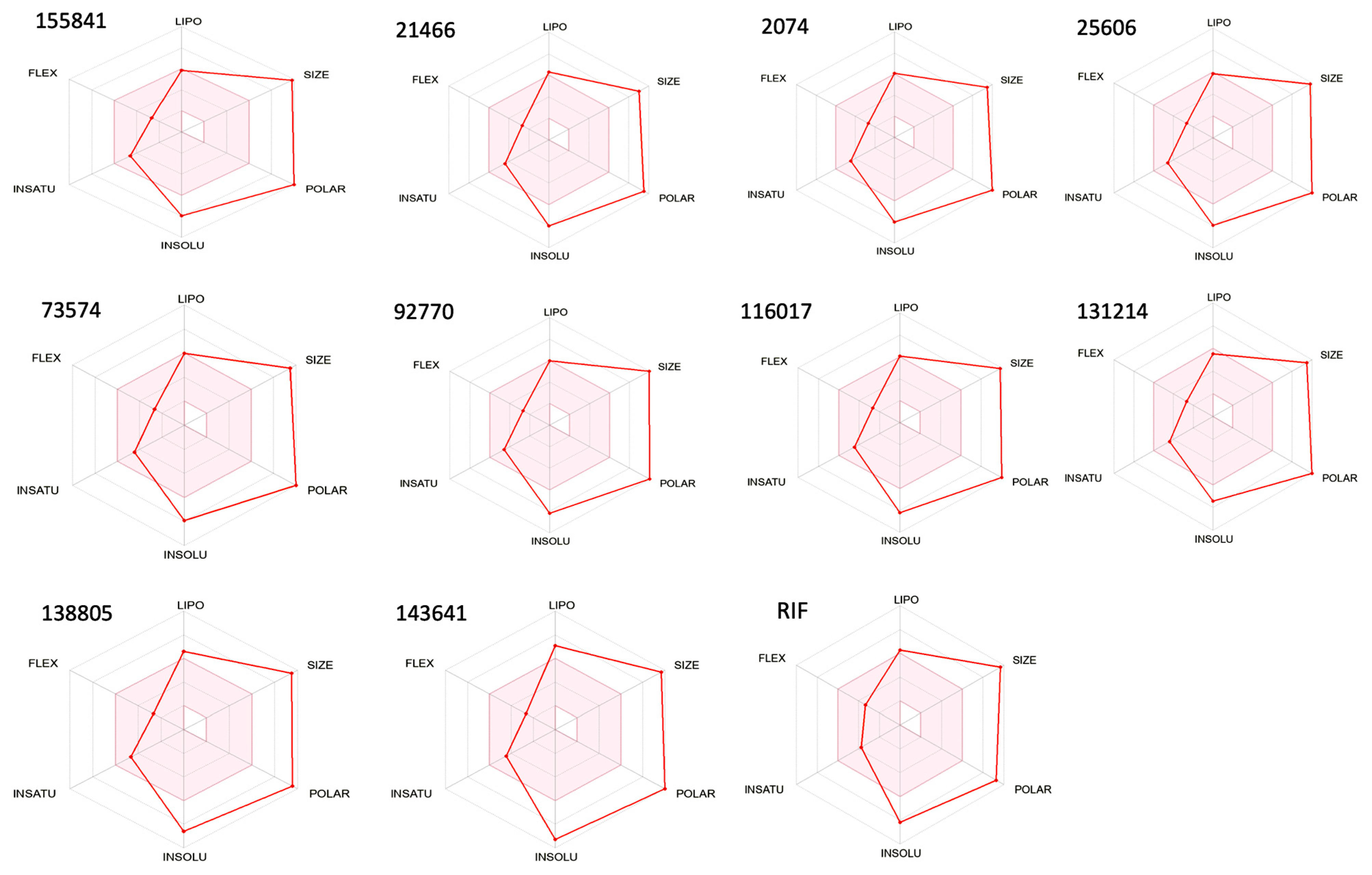
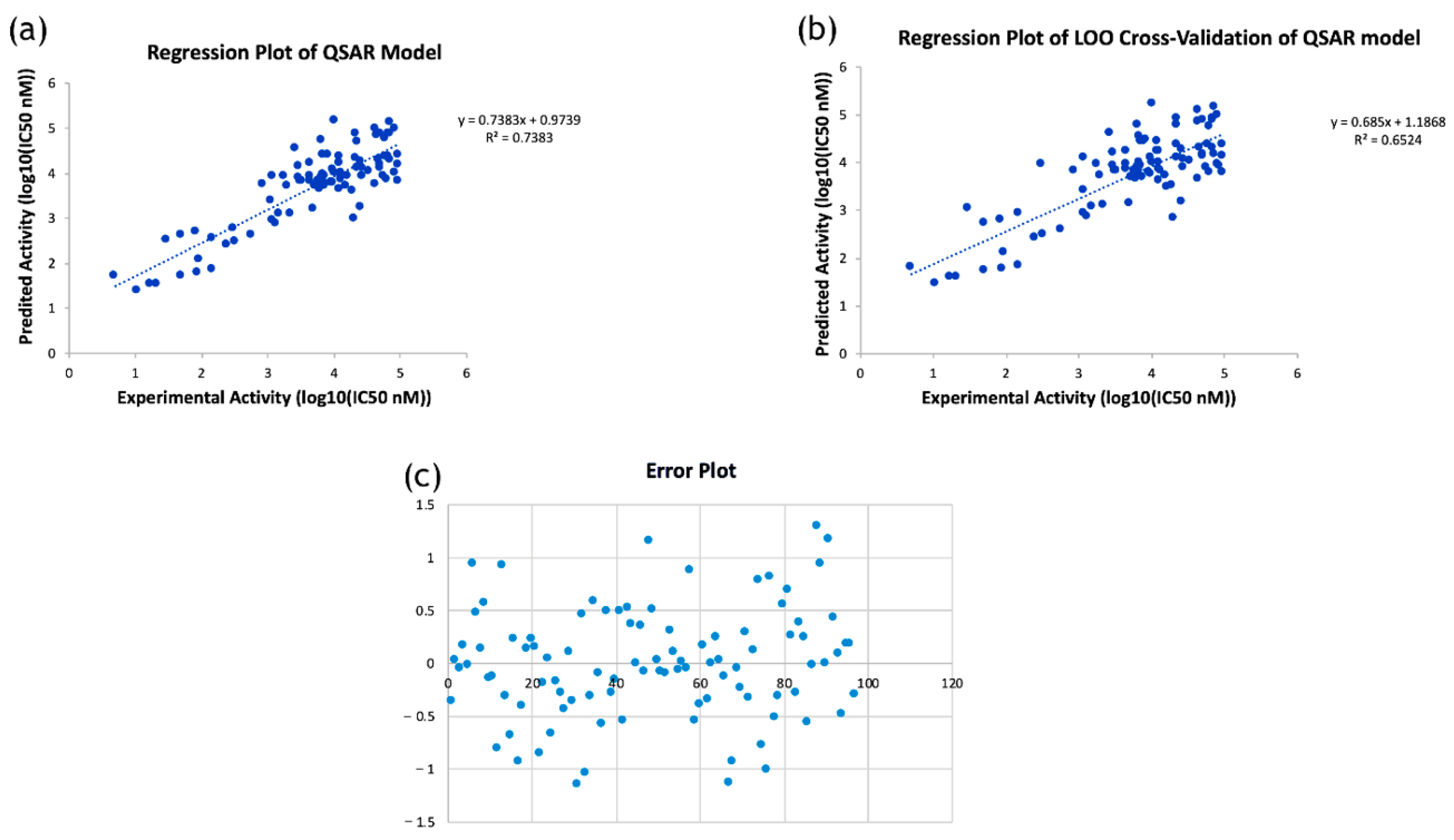
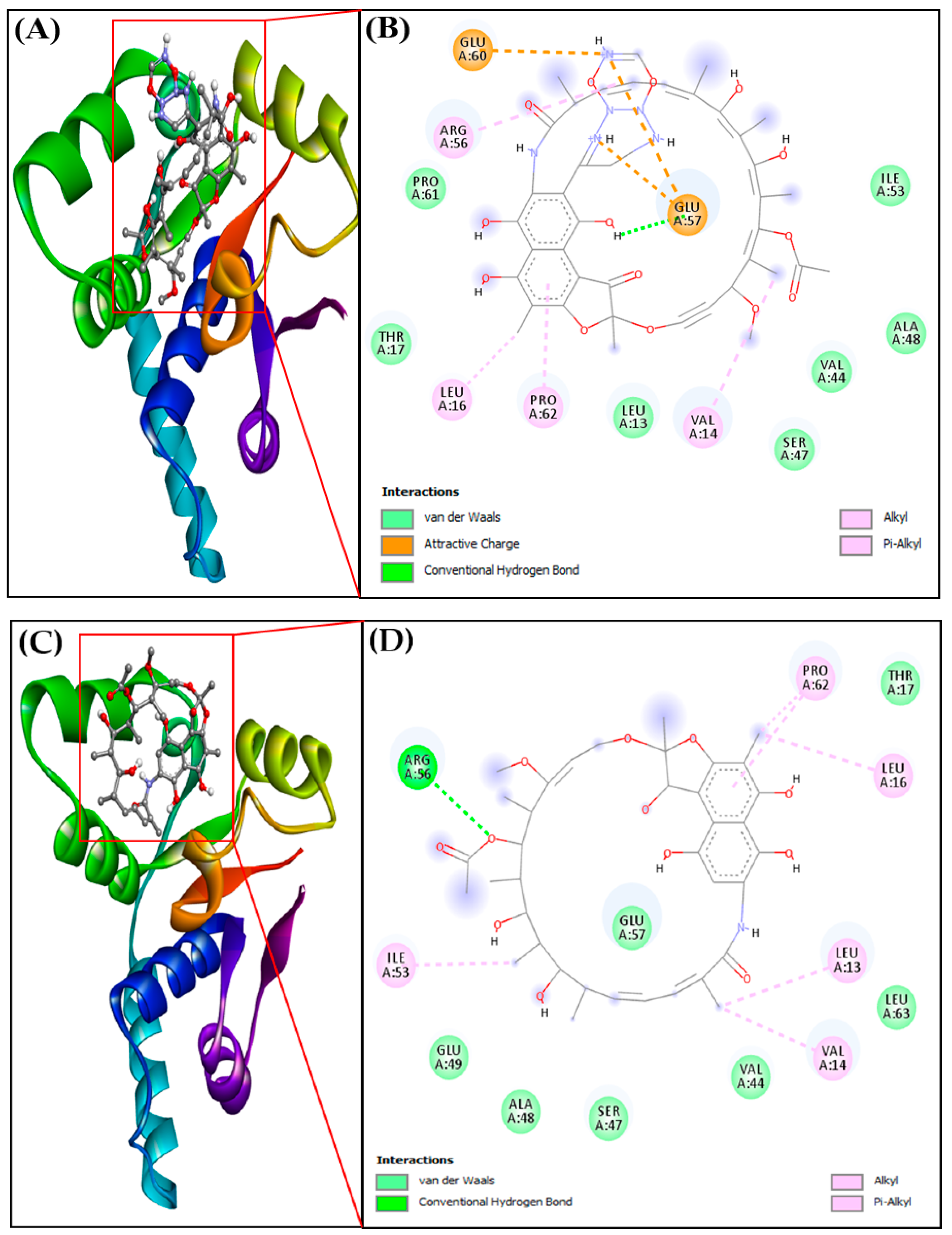
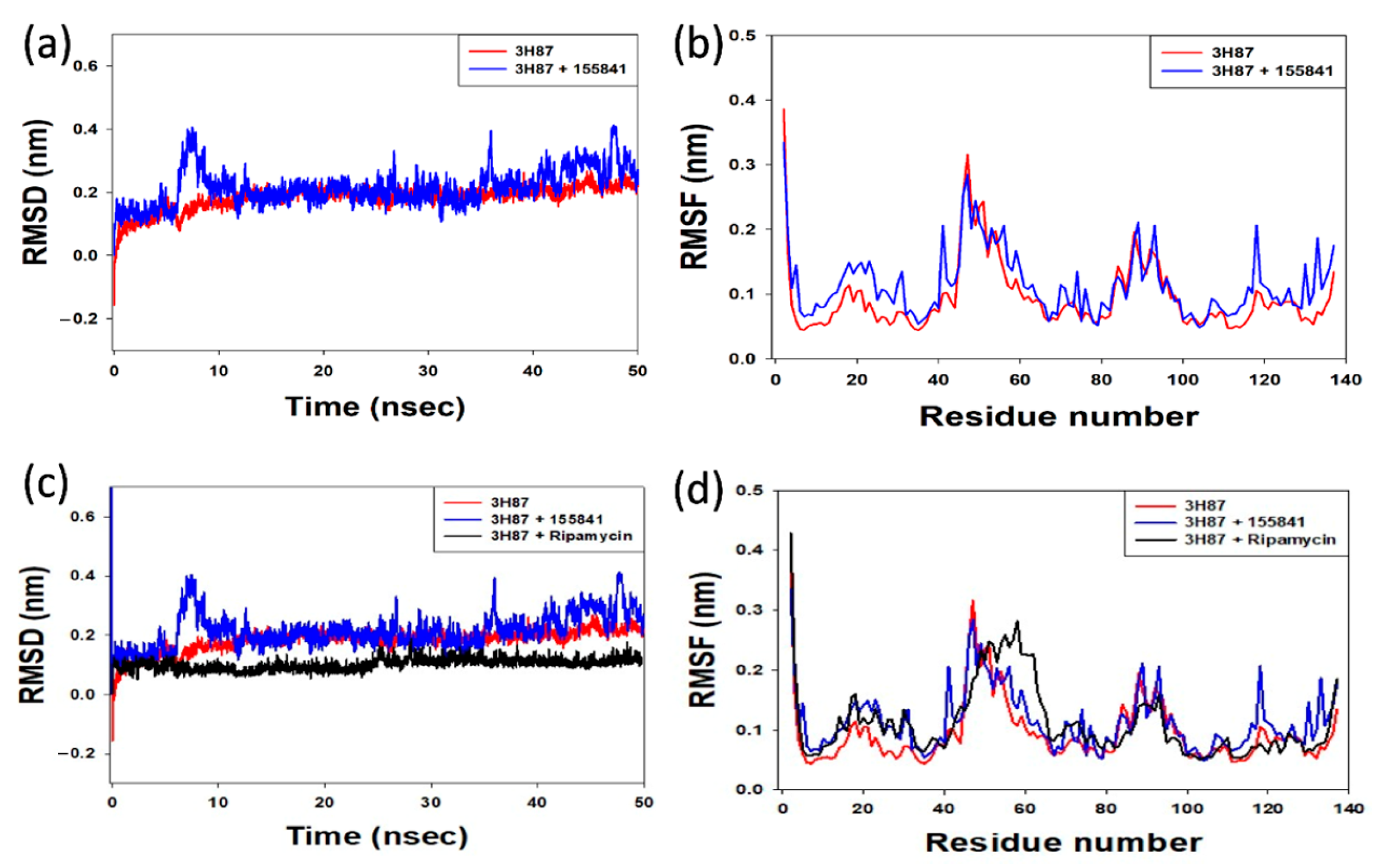

| Parameters | Optimum Range | Rifampicin | RIF 155841 | RIF 2074 | RIF 21466 | RIF 25606 | RIF 73574 | RIF 92770 | RIF 116017 | RIF 131214 | RIF 138805 | RIF 143641 |
|---|---|---|---|---|---|---|---|---|---|---|---|---|
| Size | MW between 150 and 500 g/mol | 822.94 | 836.84 | 833.83 | 764.81 | 804.84 | 832.85 | 804.84 | 848.91 | 837.89 | 804.84 | 803.85 |
| Number of Rotatable bonds | Not more than 9 rotatable bonds | 5 | 4 | 4 | 4 | 4 | 4 | 4 | 4 | 4 | 4 | 4 |
| #H-bond acceptors | No more than 10 hydrogen bond acceptors | 14 | 17 | 17 | 14 | 15 | 16 | 15 | 15 | 15 | 15 | 14 |
| #H-bond donor | No more than 5 hydrogen bond donors | 6 | 6 | 6 | 6 | 7 | 6 | 6 | 6 | 7 | 7 | 6 |
| XLOGP3 | Between −0.7 and +5.0 | 5.46 | 7.34 | 4.71 | 5.53 | 5.1 | 4.72 | 4.96 | 4.94 | 5.1 | 4.16 | 6.03 |
| ESOL Log S | Less than 6 | −8.18 | −9.64 | −7.95 | −8 | −8.01 | −7.95 | −7.92 | −8.19 | −8.21 | −7.42 | −8.59 |
| TPSA (Å2) | Must be between 20 and 130 | 220.15 | 275.08 | 270.44 | 227.34 | 256.02 | 261.71 | 244.64 | 276.81 | 288.44 | 260.18 | 227.59 |
| Fraction of Csp3 | Must not be less than 0.25 | 0.53 | 0.45 | 0.43 | 0.45 | 0.44 | 0.43 | 0.44 | 0.43 | 0.44 | 0.45 | 0.42 |
| Name/Structure of RIF Derivative | Predicted Activity Log10 (IC50) | Predicted Activity (IC50 nM) |
|---|---|---|
| RIF 2074 | 4.42 | 26,376.59 |
| RIF 21466 | 4.20 | 15,997.57 |
| RIF 25606 | 3.60 | 3983.70 |
| RIF 73574 | 4.00 | 10,022.07 |
| RIF 92770 | 3.64 | 4399.95 |
| RIF 116017 | 4.26 | 18,004.64 |
| RIF 131214 | 4.54 | 34,973.04 |
| RIF 138805 | 4.44 | 27,829.03 |
| RIF 143641 | 5.46 | 285,648.34 |
| RIF 155841 | 4.41 | 25,711.36 |
| Target Protein | Ligands | Docking Energy (kcal mol−1) |
|---|---|---|
| 3H87 | Rifampicin | −6.8 |
| 155,841 (Derivative 1) | −8.1 | |
| 116,017 (Derivative 2) | −7.9 | |
| 138,805 (Derivative 3) | −7.8 | |
| 92,770 (Derivative 4) | −7.8 | |
| 73,574 (Derivative 5) | −7.8 | |
| 25,606 (Derivative 6) | −7.7 | |
| 131,214 (Derivative 7) | −7.6 | |
| 2074 (Derivative 8) | −7.2 | |
| 143,641 (Derivative 9) | −6.9 | |
| 21,466 (Derivative 10) | −6.7 |
| Donor-Acceptor Pairs | Distance (Å) | Type of Interaction | Docking Energy (kcal mol−1) | Binding Affinity (M−1) |
|---|---|---|---|---|
| 3H87-155841 complex | ||||
| LIG: N–GLU57:OE2 | 5.2186 | Electrostatic | −8.1 | 8.73 × 105 |
| LIG: N–GLU57:OE2 | 5.5269 | Electrostatic | ||
| LIG: N–GLU60:OE1 | 3.8458 | Electrostatic | ||
| LIG:H–GLU57:OE1 | 2.2104 | Conventional Hydrogen Bond | ||
| LIG:C–VAL14 | 4.6644 | Hydrophobic (Alkyl) | ||
| LIG:C–LEU16 | 3.9970 | Hydrophobic (Alkyl) | ||
| A: ARG56–LIG | 5.4696 | Hydrophobic (Pi-Alkyl) | ||
| LIG–PRO62 | 4.3944 | Hydrophobic (Pi-Alkyl) | ||
| 3H87-Rifamycin complex | ||||
| ARG56:HH22–LIG: O | 2.2590 | Conventional Hydrogen Bond | −6.8 | 9.72 × 104 |
| LIG:C–ILE53 | 4.9650 | Hydrophobic (Alkyl) | ||
| LIG:C–LEU16 | 4.8045 | Hydrophobic (Alkyl) | ||
| LIG:C–PRO62 | 3.7328 | Hydrophobic (Alkyl) | ||
| LIG:C–LEU13 | 3.6771 | Hydrophobic (Alkyl) | ||
| LIG:C–VAL14 | 3.9681 | Hydrophobic (Alkyl) | ||
| LIG–PRO62 | 4.7323 | Hydrophobic (Pi-Alkyl) | ||
Disclaimer/Publisher’s Note: The statements, opinions and data contained in all publications are solely those of the individual author(s) and contributor(s) and not of MDPI and/or the editor(s). MDPI and/or the editor(s) disclaim responsibility for any injury to people or property resulting from any ideas, methods, instructions or products referred to in the content. |
© 2023 by the authors. Licensee MDPI, Basel, Switzerland. This article is an open access article distributed under the terms and conditions of the Creative Commons Attribution (CC BY) license (https://creativecommons.org/licenses/by/4.0/).
Share and Cite
Maurya, S.; Jain, A.; Rehman, M.T.; Hakamy, A.; Bantun, F.; AlAjmi, M.F.; Singh, V.; Zehra, A.; Khan, F.; Haque, S.; et al. In Silico Identification of Novel Derivatives of Rifampicin Targeting Ribonuclease VapC2 of M. tuberculosis H37Rv: Rifampicin Derivatives Target VapC2 of Mtb H37Rv. Molecules 2023, 28, 1652. https://doi.org/10.3390/molecules28041652
Maurya S, Jain A, Rehman MT, Hakamy A, Bantun F, AlAjmi MF, Singh V, Zehra A, Khan F, Haque S, et al. In Silico Identification of Novel Derivatives of Rifampicin Targeting Ribonuclease VapC2 of M. tuberculosis H37Rv: Rifampicin Derivatives Target VapC2 of Mtb H37Rv. Molecules. 2023; 28(4):1652. https://doi.org/10.3390/molecules28041652
Chicago/Turabian StyleMaurya, Satyamvada, Amita Jain, Md Tabish Rehman, Ali Hakamy, Farkad Bantun, Mohamed F. AlAjmi, Vineeta Singh, Aafreen Zehra, Feroz Khan, Shafiul Haque, and et al. 2023. "In Silico Identification of Novel Derivatives of Rifampicin Targeting Ribonuclease VapC2 of M. tuberculosis H37Rv: Rifampicin Derivatives Target VapC2 of Mtb H37Rv" Molecules 28, no. 4: 1652. https://doi.org/10.3390/molecules28041652
APA StyleMaurya, S., Jain, A., Rehman, M. T., Hakamy, A., Bantun, F., AlAjmi, M. F., Singh, V., Zehra, A., Khan, F., Haque, S., & Mishra, B. N. (2023). In Silico Identification of Novel Derivatives of Rifampicin Targeting Ribonuclease VapC2 of M. tuberculosis H37Rv: Rifampicin Derivatives Target VapC2 of Mtb H37Rv. Molecules, 28(4), 1652. https://doi.org/10.3390/molecules28041652








